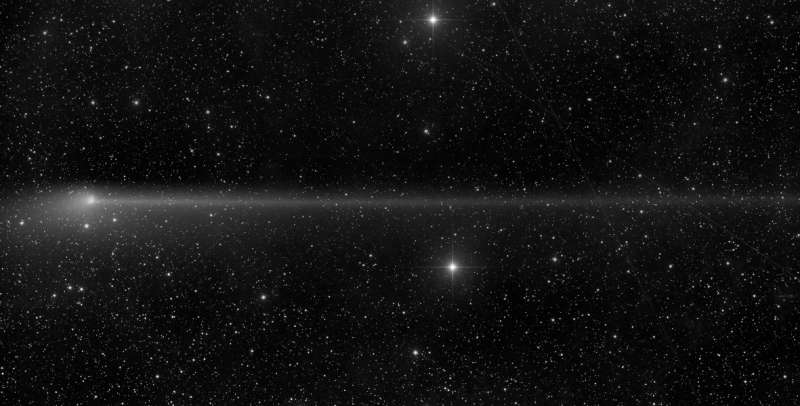Credit & Copyright: Joseph Brimacombe,
Explanation:
As planet Earth approached the plane of the
Comet PanSTARRS (C/2011 L4) orbit on May 23rd, comet watchers were
treated
to this view of its
magnificent
anti-tail.
The long, narrow anti-tail stretches
to the right across this frame for nearly 4 degrees
or about 8 times the angular size of the full Moon.
The tail trails along the comet's orbit as it
leaves the inner solar system behind.
An almost edge-on perspective from near the outbound
comet's orbital plane
enhances the view of the anti-tail and
makes it seem to point in the sunward direction,
only apparently contrary to the
behavior of comet dust tails
pushed outward by the pressure of sunlight.
Sweeping far north in planet Earth's skies,
the comet is up all night for most of the northern hemisphere,
but now bright moonlight interferes with its visibility.
PanSTARRS anti-tail is one of the longest since the appearance of
Comet Arend-Roland
in 1957.
Cosmonova:
APOD editor to speak in Stockholm on Tuesday at 6 pm
1999 2000 2001 2002 2003 2004 2005 2006 2007 2008 2009 2010 2011 2012 2013 2014 2015 2016 2017 2018 2019 2020 2021 2022 2023 2024 2025 |
Yanvar' Fevral' Mart Aprel' Mai Iyun' Iyul' Avgust Sentyabr' Oktyabr' Noyabr' Dekabr' |
NASA Web Site Statements, Warnings, and Disclaimers
NASA Official: Jay Norris. Specific rights apply.
A service of: LHEA at NASA / GSFC
& Michigan Tech. U.
|
Publikacii s klyuchevymi slovami:
dust - komety - kometnye hvosty
Publikacii so slovami: dust - komety - kometnye hvosty | |
Sm. takzhe:
Vse publikacii na tu zhe temu >> | |
